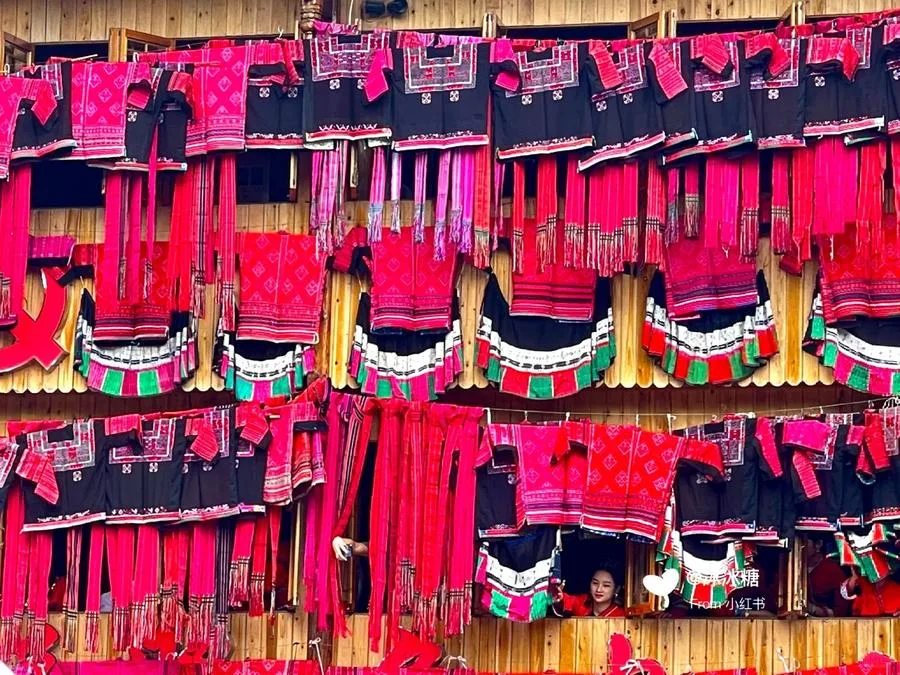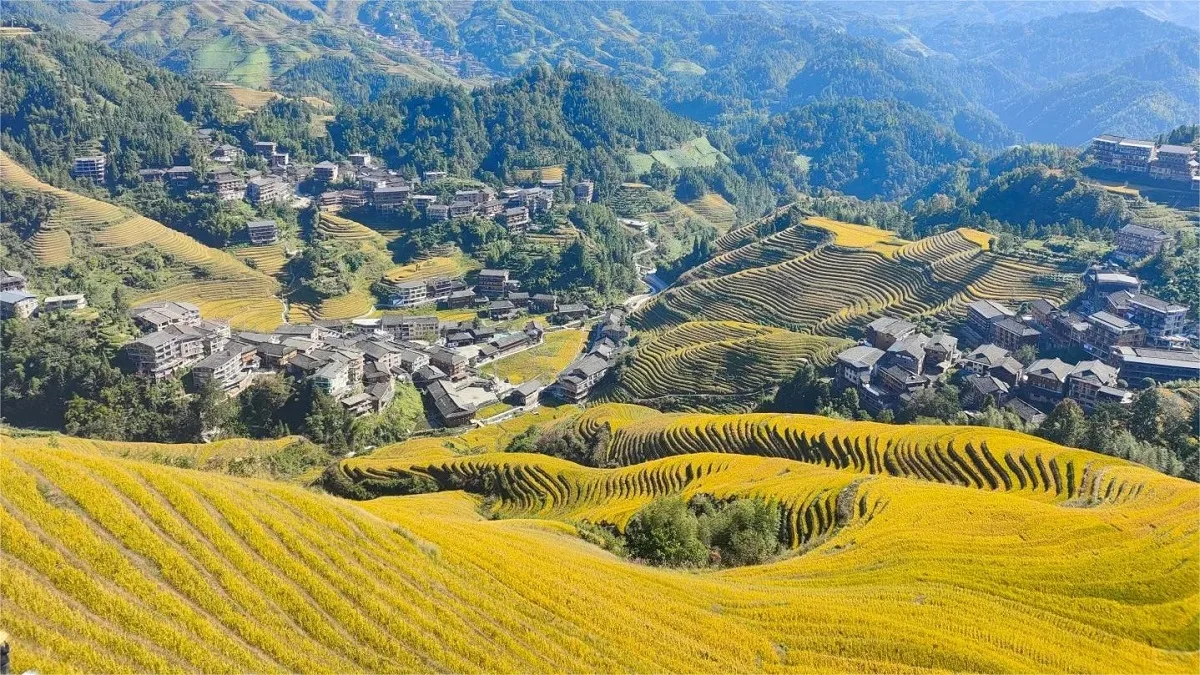Jinkeng Rice Terraces (金坑梯田), resembling a natural giant pit, are an impressive landscape stretching over 10 square kilometers. Located in a cluster of Red Yao villages, Jinkeng was named a “Classic Village Landscape of China” in 2007. The terraces are composed of five villages: Dazhai, Tiantouzhai, Zhuangjiezai, Xinzhai, and Xiaozhai. One of the highlights of the area is the long hair of the Red Yao women, which is a unique and beautiful sight. Due to its late development, the area maintains a less commercialized and more authentic rural atmosphere.
Jinkeng Rice Terraces feature three main viewing points: West Hill Shaole (1st Viewing Point): This spot, with a high altitude and broad vistas, is perfect for capturing both sunrise and sunset; Thousand-Layer Ladder (2nd Viewing Point): Known for its easy accessibility, this point is ideal for sunrise views and offers a glimpse of the Yao villages. Golden Buddha Peak (3rd Viewing Point): Renowned as the best location for sunset photography, this spot is now more accessible with the recently opened cable car from the entrance of the Dazhai Scenic Area to Golden Buddha Peak.
Table of Contents
- Basic Information
- Location and Transportation
- Best Time to Visit Jinkeng
- How to Tour Around
- Residents of Jinkeng Rice Terraces
- Vlog about Jinkeng Rice Terraces
Basic Information
| Estimated Length of Tour | 1 – 2 hours |
| Ticket Price | Included in the ticket for Longji Rice Terraces |
| Opening Hours | 24 hours a day throughout the year |
| Telephone Number | 0086-0773-7583188 |
Location and Transportation
Jinkeng Rice Terraces are located within the Longji Rice Terraces Scenic Area in Longsheng County, Guilin, Guangxi Zhuang Autonomous Region, China. To get there, you can choose one of the following ways:
From Guilin, you can take a bus from the Guilin Qintan Bus Station to Longsheng County. Buses run daily from 6:10 AM to 5:50 PM, departing every 20 minutes. The fare is 21 yuan. Along the way, the bus stops at three main entrances to the Longji Rice Terraces: Longji Ancient Zhuang Village, Ping’an Zhuang Village, and Dazhai Red Yao Terraces
Alternatively, you can start your journey from Longsheng County. Buses from Longsheng to the scenic area operate from 7:00 AM to 5:00 PM, with departures every half hour. These buses will take you to the major entrances of the Longji Rice Terraces, including Dazhai and Longji Ancient Zhuang Village.
Best Time to Visit Jinkeng

Spring Scenery (April 25 – June): The rice fields are irrigated by spring rain, resembling mirrors. The freshly planted seedlings give the mountains a vibrant green hue, embodying the vitality of spring.
Summer Scenery (Peak Season) (Mid-June to Mid-July): The area is cool, and the lush green rice fields present a lively scene of harmony between humans and nature.
Autumn Scenery (Peak Season) (Mid-July to around the Mid-Autumn Festival and National Day): The rice ears are ready for harvest by the eighth lunar month. The golden autumn landscape is so stunning that the fields are usually kept until after the Mid-Autumn Festival and National Day holiday.
Winter Scenery (Off-Season): There are only a few opportunities each year to encounter snow. The snow scene typically lasts 1-3 days and is a rare sight. The white snow blankets the terraces, warm houses dot the landscape, and the air is filled with the scent of preserved foods.
How to Tour Around

Cable Car: You can take the Longji Jinkeng Cable Car, which allows visitors to enjoy the panoramic view of the Longji Rice Terraces and the beautiful scenery along the way in just 20 minutes. The sightseeing cable car at Jinkeng Terraces is a single-line circulating four-person gondola, with a total length of 1,380 meters and a height difference of 310 meters, equipped with 113 gondolas.
Longji Gorge Rafting: Longji Gorge Rafting is located within the Longji Rice Terrace Scenic Area, 77 kilometers from Guilin city center. The rafting route is 4 kilometers long with a height difference of 300 meters, and the entire rafting experience takes about 1.5 hours. Rafting is available at three times: 10:00 AM, 1:30 PM, and 4:00 PM. Each inflatable raft accommodates two people.
Residents of Jinkeng Rice Terraces

The residents of Jinkeng Rice Terraces are primarily the Red Yao people, a branch of the Yao ethnic group. Their ancestors migrated from the Dongting and Wuxi areas in Hunan, bringing advanced rice planting techniques. The Red Yao do not have their own written language, and their history and culture have been passed down orally through folk songs. The Red Yao people are hardworking, brave, honest, and hospitable. The women are particularly skilled in handicrafts, known for their embroidery, weaving, batik, and silk-making. Red Yao women love to wear red clothing, which is why they are called Red Yao.


